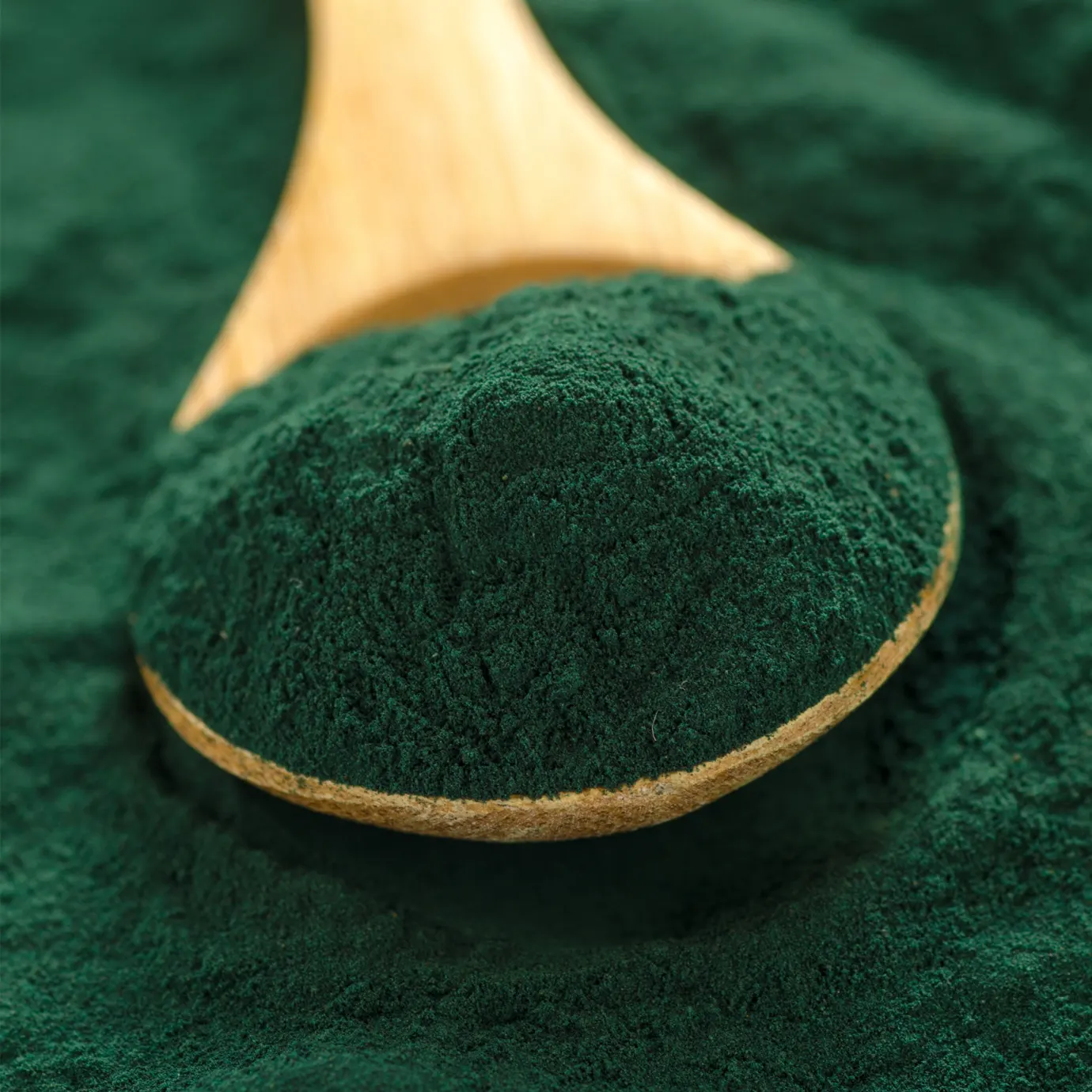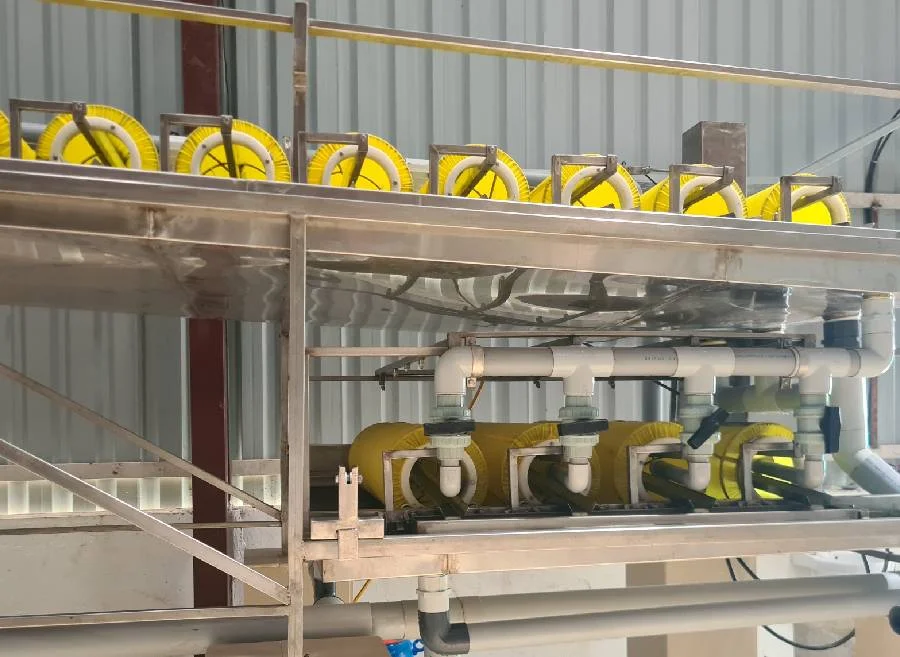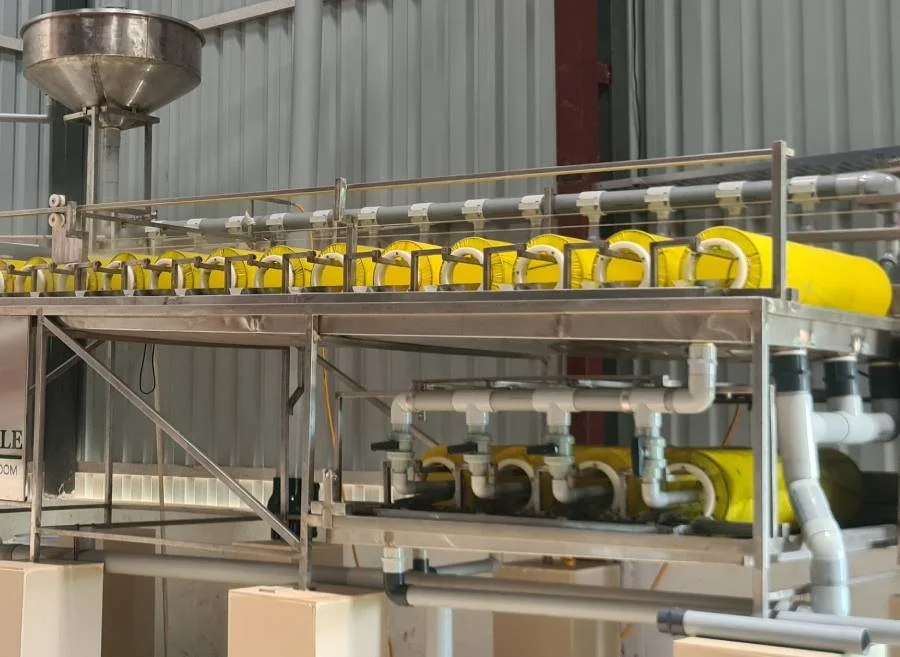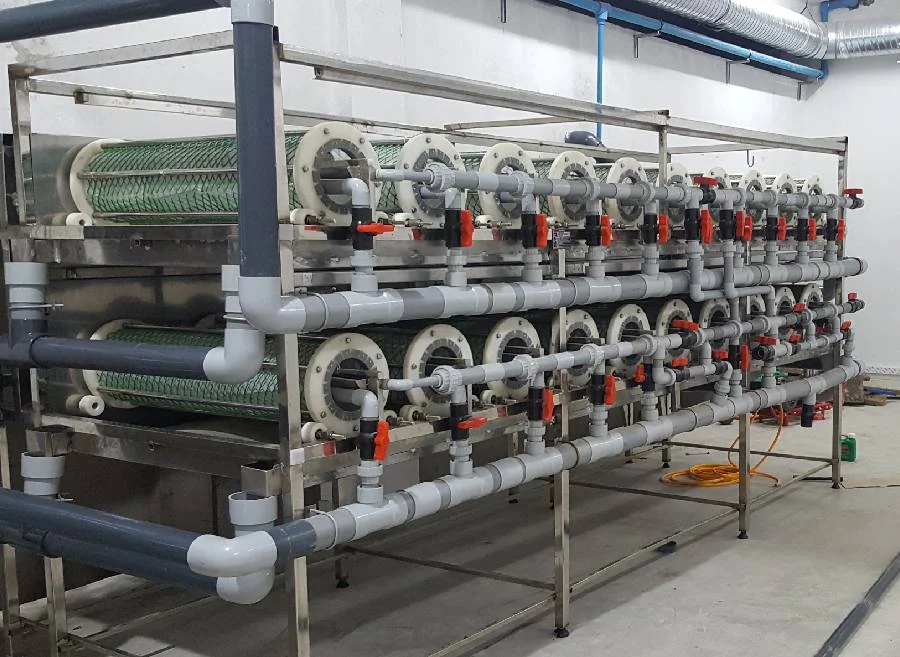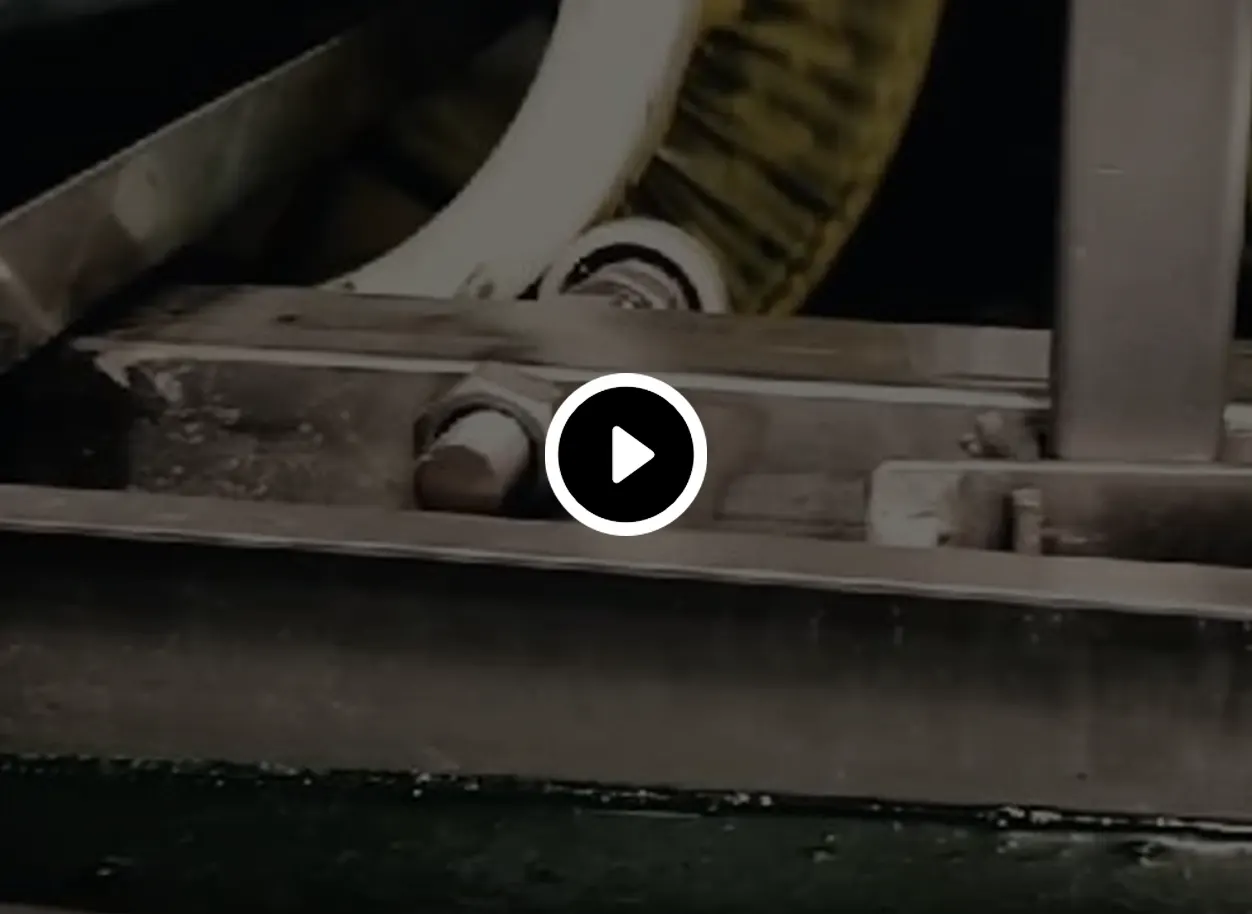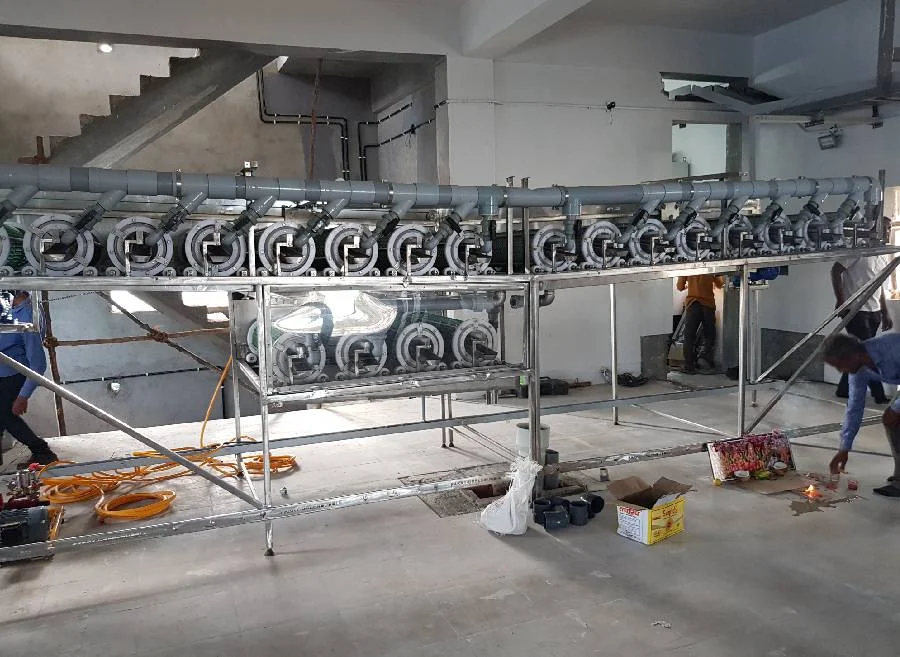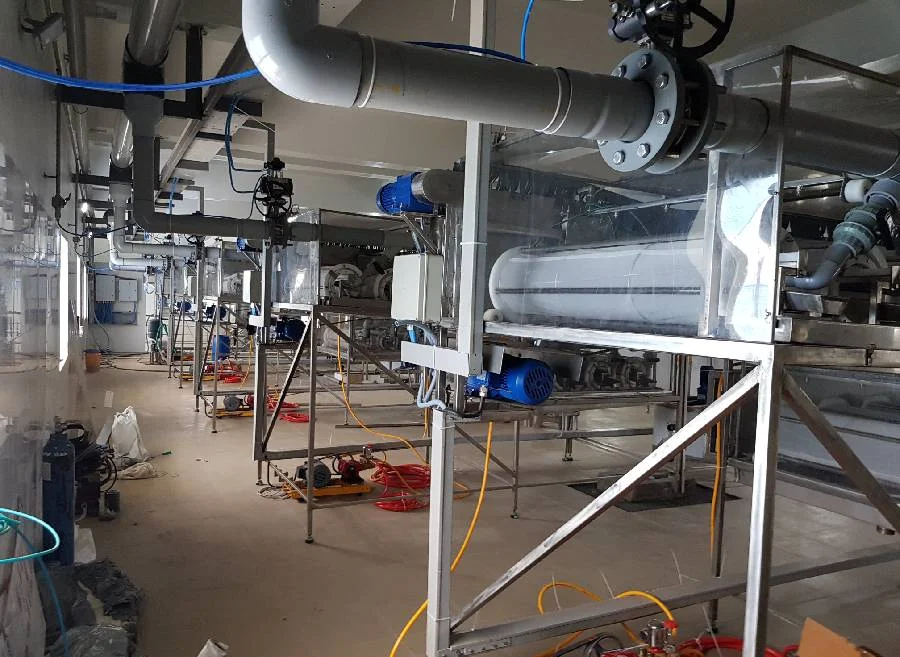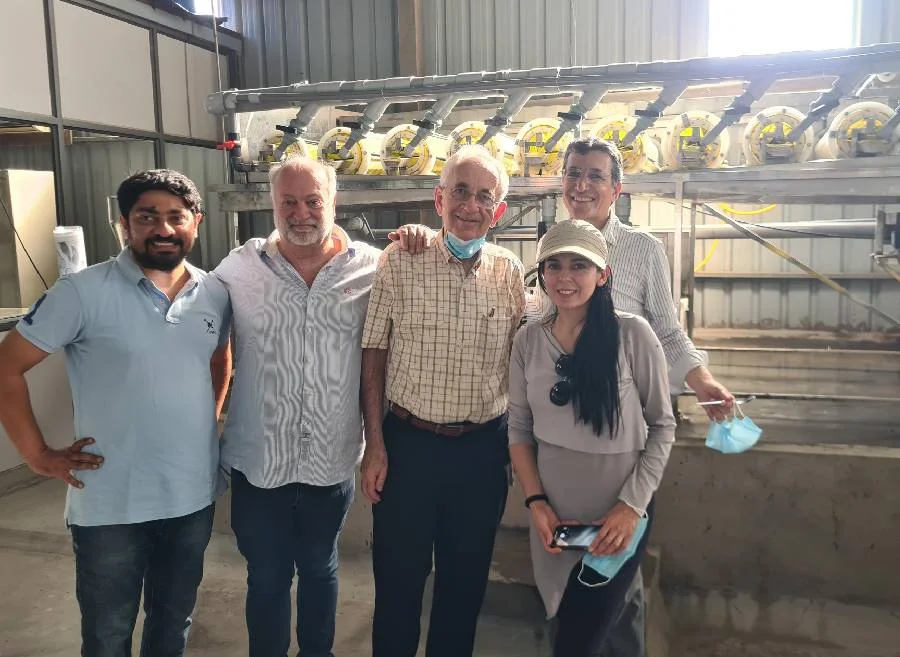Efficient, Sustainable & Globally Trusted Harvesting Technology
Harvesting microalgae like spirulina is no small task—especially when purity and sustainability are non-negotiable. Our patented harvesting machines are engineered to work with low-concentration spirulina cultures, using gentle methods that protect cell integrity, optimize biomass collection, and minimize energy use. The result? Reliable, high-quality output at lower operational costs.
Designed for Real-World Spirulina Harvesting Challenges
Performance That Matches Your Ambition
Traditional spirulina harvesting methods often fall short when it comes to scale, sustainability, and quality control. Manual labor is time-consuming, while conventional automated systems—like decanters or high-speed centrifuges—demand heavy electricity, frequent maintenance, and come with a high risk of damaging delicate spirulina cells.
At Greenbubble, we’ve reimagined spirulina harvesting from the ground up. Our solution leverages gentle gravity-based separation, low-energy motors, and food-grade filtration systems to ensure your yield is not just high—but clean, consistent, and compliant with export-grade quality standards.
Our systems are already operating successfully in over eight countries, helping farms process more than 2000 tons of algae annually. Built using corrosion-resistant materials and engineered for plug-and-play scalability, our machines are designed to grow with your business—whether you’re starting with a 5,000-liter unit or scaling to 50,000+ liters daily.
Long-Term Gains, Minimal Downtime
Every detail—from our power-saving mechanisms to our minimal-maintenance setup—is optimized for long-term cost-effectiveness. You won’t need daily troubleshooting, constant repairs, or third-party intervention. Instead, you’ll gain a harvesting system that frees up your labor, reduces utility costs, and elevates your entire post-cultivation process.
This is spirulina harvesting—built for tomorrow, delivered today.
Smarter Spirulina Harvesting
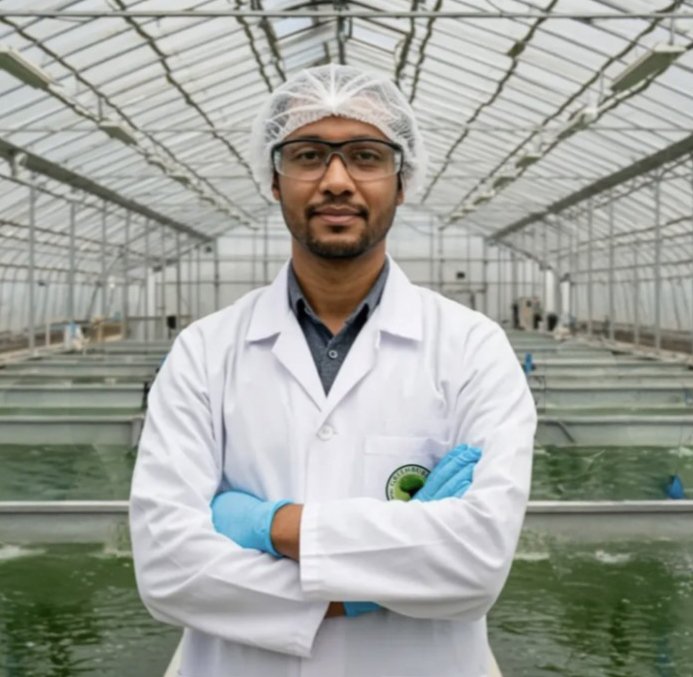
Widely Adopted
Deployed across 8 countries with repeat orders from happy clients.
Gentle Gravity Harvesting
Protects cell structure and ensures superior output quality.
Low Maintenance
Built for durability—reduces breakdowns and service costs.
Eco-Friendly Design
Lower energy needs = lower emissions and footprint.
Energy-Efficient Processing
Uses only 1 unit of power for every 50,000+ liters of culture.
Smart Engineering
Designed to outperform costly traditional systems without compromising quality.
At Greenbubble, we believe that world-class spirulina harvesting should be both effective and accessible to farms of every scale. Our custom-engineered harvesting systems are built with precision to meet the specific needs of commercial spirulina producers—balancing quality, sustainability, and ease of operation. Whether you’re upgrading outdated equipment or setting up a new high-efficiency unit, we provide harvesting solutions that minimize manual intervention, reduce energy consumption, and protect biomass integrity throughout the process. From filtration and dewatering to gentle biomass handling, every component is thoughtfully designed to help you meet international quality benchmarks while staying cost-effective. Our systems are field-tested, farmer-validated, and built to grow with your operation.
Spirulina Farming FAQs
Everything You Need to Know About Commercial Spirulina Farming – From Setup to Profitability!
Following parameters need to be met while selecting land to set up a plant.
- low cyclone area
- flat land
- road approach
- less rainfall
- no hills or mountain shadow
- high temperature and dry land
- Mild or higher temperatures in winters
- water source (preferably ground water)
- Spirulina usually grows in hot & extremophile conditions and can sustain very high temperatures
Land Selection Criteria for a Spirulina Production Plant [Detailed Version]
1. Climate & Location Suitability
| Parameter | Requirement | Why It Matters |
|---|---|---|
| Cyclone / Wind Risk | Low-risk zone | Protects ponds, sheds, power lines, and prevents operational disruptions |
| Rainfall & Humidity | Low rainfall, low humidity (dry regions preferred) | Reduces pond dilution/overflow risk and lowers drying energy load |
| Sunlight Availability | High sunlight, minimal cloud cover | Directly improves Spirulina productivity and growth consistency |
| Shadow-Free Area | No hills, mountains, or tall obstructions | Prevents sunlight blockage and uneven pond temperatures |
| Temperature Profile | Warm-to-hot summers, mild winters | Enables stable year-round production with minimal winter downtime |
2. Topography & Civil Suitability
| Parameter | Requirement | Why It Matters |
|---|---|---|
| Land Gradient | Flat land | Minimizes earthwork and ensures uniform pond depth |
| Flood Risk | Non-flooding plot with natural drainage | Prevents contamination and structural damage |
| Drainage Control | Ability to divert rainwater/runoff | Protects ponds from overflow and culture loss |
| Soil Bearing Capacity | Good bearing capacity, low settlement risk | Avoids pond deformation and liner damage over time |
3. Water Availability & Quality
| Parameter | Requirement | Why It Matters |
|---|---|---|
| Water Source | Assured year-round supply (preferably groundwater) | Ensures uninterrupted production cycles |
| Borewell Yield | Adequate and sustainable discharge | Supports scale-up and continuous operations |
| Mandatory Water Tests | pH, TDS, hardness/alkalinity, iron, manganese | Ensures culture stability and process efficiency |
| Heavy Metal Testing | Mandatory (especially for export) | Critical for food-grade and international compliance |
| Legal Permissions | Groundwater extraction permissions checked | Avoids regulatory issues and shutdown risks |
4. Access & Utilities
| Parameter | Requirement | Why It Matters |
|---|---|---|
| Road Access | All-weather motorable road | Smooth movement of machinery, inputs, and dispatch |
| Electricity Supply | Reliable grid power | Essential for aeration, pumps, dryers, and lighting |
| Backup Options | Space for DG set / solar | Ensures power continuity during outages |
| Telecom & Internet | Stable mobile and data connectivity | Required for monitoring, CCTV, automation, and reporting |
5. Contamination Risk & Compliance Readiness
| Parameter | Requirement | Why It Matters |
|---|---|---|
| Industrial Distance | Far from factories, quarries, dumping yards | Prevents air and water contamination |
| Sewage & Effluents | No nearby sewage channels or drains | Eliminates biological and chemical contamination risk |
| Pesticide Drift | Avoid high pesticide-use agricultural zones | Important for premium, organic, and export markets |
| Land Title & Legal | Clear ownership and approval feasibility | Smooth project execution and financing |
| Expansion Potential | Scope for future expansion | Spirulina operations benefit significantly from scale |
Both Central & State Governments have multiple schemes and subsidies depending on the zone or region where the project will be built. These schemes are available with capital subsidy incentive, interest subsidy incentive and as financing schemes – subject to availability based on the applicant’s profile, state & Region.
Yes, the demand for spirulina in India is rising due to its superfood status and benefits like high protein (60%+), antioxidants, balanced amino acid profile and essential vitamins. The nutraceutical, pigment industries and cosmetic industries drive the bulk demand, with additional interest from the animal feed, aquaculture sectors and bio fertilizers. Health-conscious consumers are increasingly seeking organic spirulina, making certified farms more competitive. However, export markets (EU, USA) offer higher profit margins and volumes because of higher consumption and awareness in their respective countries.
Spirulina quality is assessed in laboratories for key parameters like protein content (≥60%), phycocyanin levels (≥15%), heavy metals (lead, mercury, arsenic), microbial contamination, and purity. The Certificate of Analysis (COA) from third-party labs ensures compliance with global standards like USDA Organic, EU Organic, GMP, and HACCP. A simple at-home test includes checking colour (deep green-blue) and smell (fresh, non-fishy). For commercial-grade quality assurance, regular lab testing and batch tracking are essential.
Spirulina is relatively easy to cultivate under the right conditions, but maintaining high quality can be challenging. It thrives in high-pH, mineral-rich water with consistent agitation and ample sunlight. However, farms must closely monitor for contamination—such as heavy metals, harmful bacteria, and cross-contamination with other algae. Maintaining an optimal pH level (between 9 and 11) and using controlled drying methods are essential to preserve its nutritional value. Scaling up production requires automation of processes like filtration, harvesting, drying, and packaging, making commercial farming significantly more complex than small-scale setups.
Yes, India exports spirulina, but it requires strict regulatory compliance. To export, farms must obtain FSSAI, USDA Organic, and EU Organic certifications, ensuring compliance with global quality standards. Countries like the USA, EU, and Japan demand batch tracking, third-party lab testing (COA), and HACCP/GMP practices to verify purity. Organic-certified spirulina fetches higher prices, but maintaining consistent quality, low contamination levels, and proper documentation is crucial for global acceptance.
The ideal tank size for spirulina farming depends on production goals. Small-scale hobby farms can start with 1,000-5,000 litres (10-50 sq. m. tanks), while commercial farms require multiple tanks ranging from 4lakh to 8lakh litres for viability and to meet market demand. Tanks should be food-grade, contamination-free, and have an efficient agitation system to ensure even nutrient distribution. The depth should be around 20-30 cm, allowing optimal light penetration for photosynthesis. Regular pH, temperature, and contamination checks are crucial for consistent yields.
There are multiple Spirulina species, and the best one depends on the intended use. Arthrospira platensis is widely used due to its high protein content (60–70%), β-carotene, and phycocyanin levels. It is also GRAS-approved by the FDA, which makes it easier to market and sell. When choosing Spirulina, opt for organic-certified, lab-tested products with high phycocyanin content (≥15%) for the best health benefits. Low-quality, mass-produced Spirulina may contain toxins, heavy metals, or reduced nutrient levels. Therefore, selecting products that come with a valid Certificate of Analysis (COA) is essential.
Spirulina is expensive due to its high-quality control standards and nutrient-rich composition. Factors like pH balance, controlled agitation, organic compliance, and industrial nutrition preserving dryers increase production costs. Organic-certified spirulina requires third-party testing (HACCP, GMP, USDA Organic) for contaminants like heavy metals and bacteria, adding to expenses. Additionally, import restrictions and packaging for nutrient retention contribute to the high pricing. Despite the cost, its superior nutritional profile and increasing demand justify the premium.
Countries like the Japan, Thailand, and China lead in commercial spirulina production. France and Germany also produce premium-grade spirulina in small scales, often cultivated in controlled greenhouse environments. Indian spirulina has strong potential, but farms must focus on organic certification and contamination-free production to compete with global suppliers.
Yes, the demand for spirulina in India is rising due to its superfood status and benefits like high protein (60%+), antioxidants, balanced amino acid profile and essential vitamins. The nutraceutical, pigment industries and cosmetic industries drive the bulk demand, with additional interest from the animal feed, aquaculture sectors and bio fertilizers. Health-conscious consumers are increasingly seeking organic spirulina, making certified farms more competitive. However, export markets (EU, USA) offer higher profit margins and volumes because of higher consumption and awareness in their respective countries.
To start a spirulina farm, you need a warm climate (25-50°C), Fresh potable water and a contamination-free environment. Begin by setting up growth tanks (preferably food-grade material), an agitation system, and an organic nutrient supply. Ensure regular water testing, lab analysis for purity, and compliance with organic standards for targeting premium markets. Drying and packaging should use low-heat methods to retain nutrients. Marketing strategies should focus on B2B (nutraceuticals, pigment, cosmetics) and direct-to-consumer (powders, tablets, supplements). Hiring consultants can help you cover all bases and avoid costly mistakes during setup and operation.
The cost of starting a spirulina farm varies based on scale and automation level. A small-scale Hobby farm (1,000 sq. ft.) may cost around ₹5-10 lakh, while a commercial setup can exceed ₹1CR due to expenses like land preparation, building costs, Machineries, Raceway tanks construction, agitation systems, working capital, electrical and plumbing, lab setup many other management and administrative expenses. Key costs include Civil works, harvesting, drying system (Industrial nutrition preserving dryers), certification expenses (like FSSAI, USDA Organic, EUO, ECOCERT, HACCP, GMP) and working capital. While initial investment is high, proper planning, market positioning and quality assurance can yield significant returns.
Spirulina farming can be highly profitable, but success depends on factors like production scale, automation, organic certification, Quality and market demand. While some claim an ROI of 300% within months, realistic profitability takes 2-3 years due to high setup costs for infrastructure to reduce labour dependency, increased up time and meet the quality standards. Organic-certified spirulina fetches premium prices in domestic and international markets, making it a viable long-term investment. However, strict quality control, regulatory compliance, and a reliable distribution network are key to ensuring consistent profitability.
Related Services
Let us help you
